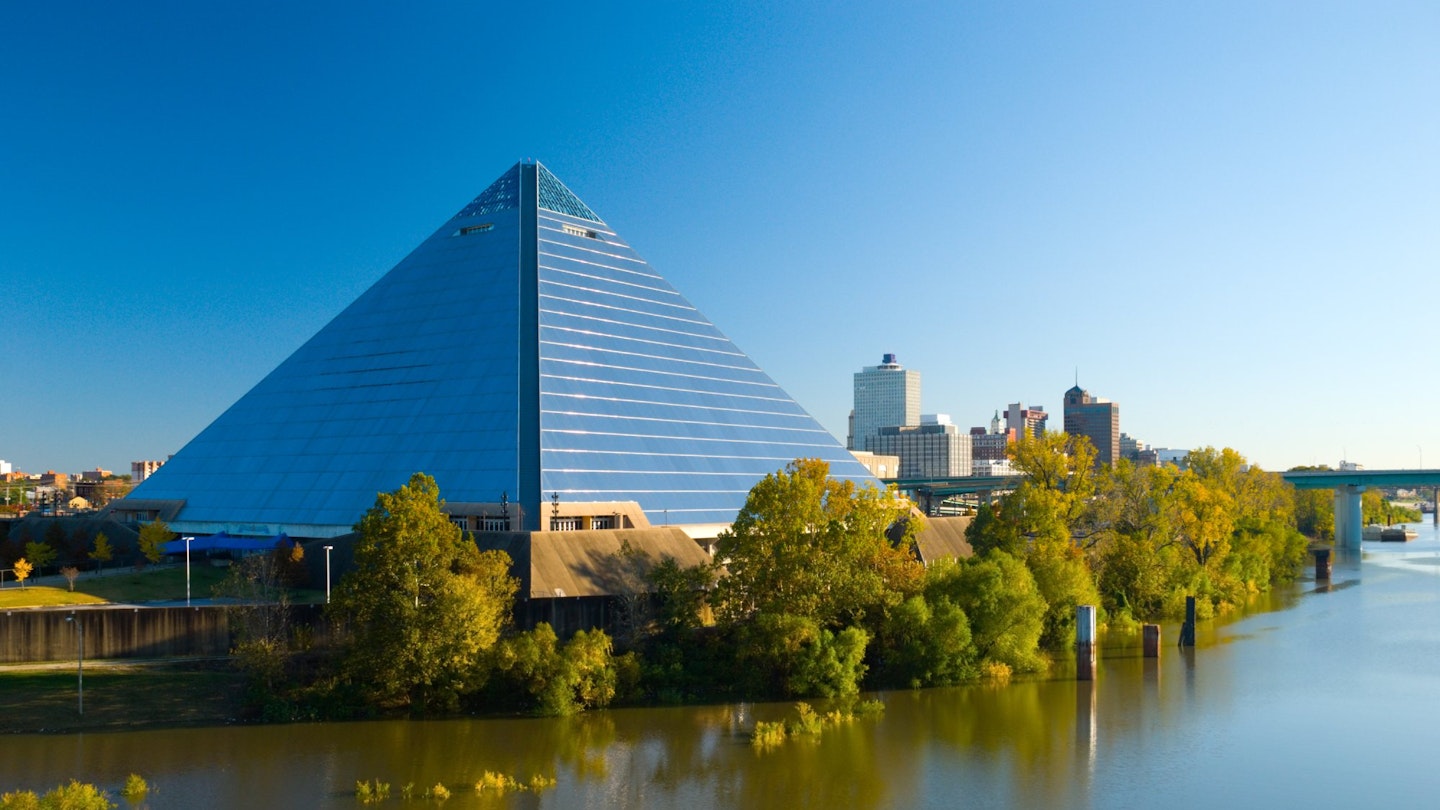On the banks of the Mississippi River, just north of downtown , stands one of the largest pyramids in the world, 321 feet from base to apex. If placed next to the most famous of , it would be the third-tallest in the group. Despite lacking the historic intrigue of its Egyptian counterparts, it harbors layer upon layer of fascinating stories.
The Memphis Pyramid was always intended to be a prominent landmark. Although music helped put the Tennessee city on the map—home to and , the self-proclaimed “Birthplace of Rock ‘n’ Roll”—city boosters aimed for an eye-catching skyline feature akin to the Gateway Arch in St. Louis. A pyramid seemed a fitting choice, being aligned with the city’s namesake in Egypt and the existing local Egyptian-inspired architecture, such as the historic Universal Life Insurance building.
The Origin of the Memphis Pyramid
The initial concept arose from artist Mark Hartz in the 1950s, envisioning three pyramids atop bluffs as a captivating sight. Although that vision did not materialize, in the mid-1980s, encouraged by his son Jon, Hartz produced an elegant rendering for a single, gold-glimmering pyramid. The Hartz duo “had no [concrete] plans or money for it,” recalls Michael Finger, a historian and executive editor of Memphis magazine. “They just thought it was a cool idea. [Jon] went around to drum up interest. Everyone thought it was either crazy or extremely brilliant.” However, it was unclear what purpose the pyramid would serve.

This renewed effort captured the interest of John Tigrett, a Memphis local with a fortune from Glub-Glub (the drinking duck toy), and Sidney Schlenker, renowned for operating the Astrodome and its sensational events, such as the “Battle of the Sexes” tennis match.
The hyperbolic new vision for the Pyramid was eccentrically ambitious, far exceeding Mark Hartz’s initial concepts. The monumental structure would rise by the Mississippi River, integrating Mud Island into the design.
A theme park called Rakapolis was envisioned with Egyptian architecture, reed boats ferrying visitors from Mud Island to the Pyramid, and a focus on American music. The Pyramid was planned to host a rock ‘n’ roll museum or possibly a Grammy museum, with visitors entering the building “through a replica of the world’s largest trumpet,” paying homage to local hero W.C. Handy.
For better or worse, the bulk of that vision did not materialize—no reed boats, no walk-through trumpet, nor music museum. Nevertheless, the Pyramid was constructed, breaking ground in September 1989. Finger recalls the groundbreaking ceremony featured “an easily 50ft, maybe longer, shovel outlined in neon, flown by a helicopter over the site,” playing patriotic music as the shovel was dropped to mark the momentous occasion.
An Unlucky Start
The Pyramid finally opened as an arena in November 1991, showcasing stainless steel paneling outside and seating for 20,000 inside. However, it drew significant chatter from locals about a metal box, containing a crystal skull, secretly placed at the behest of John Tigrett’s son, Isaac. The inaugural event was a concert by country music duo the Judds, unfortunately upstaged when the structure experienced flooding due to restroom backups requiring sandbags to be deployed.
Despite this inauspicious beginning, the Pyramid hosted myriad memorable events, including concerts, University of Memphis Tigers basketball games, professional wrestling matches, arena football games (for the defunct Memphis Pharaohs), and more.
Crucially, the Pyramid also played a pivotal role in attracting the NBA team Grizzlies to relocate from Vancouver to Memphis in 2001. Initially, the Memphis Grizzlies played at The Pyramid. However, poor acoustics and the absence of amenities modern NBA teams require, such as luxury suites, prompted the team to seek a new venue. Consequently, in 2004, they moved to the newly constructed FedExForum, taking the University of Memphis Tigers with them, leaving the Pyramid vacant.

In 2006, Bass Pro Shops proposed taking over the building to transform it into a massive retail destination packed with attractions. Initial reactions were skeptical, as many joked about “moving a bait shop into the Pyramid.” However, Finger countered that “you don’t have to be a hunter or a fisherman to appreciate what Bass Pro has up there.”
Fast forward to 2015, the newly renovated Bass Pro Shops Pyramid opened its doors, becoming much more than a shopping venue. It features a gun range, an aquarium, multiple restaurants—including one at the top, accessed via a free-standing elevator—and even more unusual attractions, such as a fully indoor, 103-room Big Cypress Lodge, offering views of an alligator-filled cypress swamp below.
The revamped Pyramid has proven highly popular, attracting three million visitors in its first year alone, with crowds continuing to flock to this unique destination. Undoubtedly, it possesses an element of absurdity—something that’s been part of its charm. According to Michael Finger, the Memphis Pyramid, with all its idiosyncrasies, stands as a point of local pride, marking its importance as a significant landmark in Memphis.




